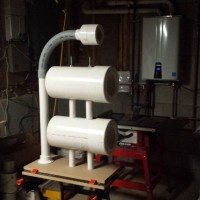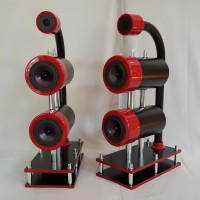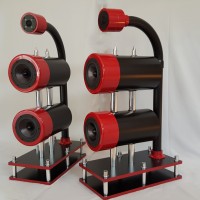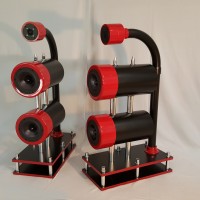
PVC Extreme
Designer: JSH
Project Category
Freestyle Speakers
Project Level
Advanced
Project Time
20+ Hours
Project Cost
Over $1,000
Project Description
This started out as a New England, mid-winter, father and son project to try to create a totally original design for a pair of floor standing speakers. It harkens back to a time about 35 years ago when my father and I built a set of speakers using Altec Lansing Voice of the Theater components. The results were terrific and I was hoping to reproduce this experience now with my son.
In 2015 we experienced record snow falls in our area, and what better way to pass the time then designing and building speakers. We wanted to build something original and unique, using readily obtainable parts, without breaking the bank or turning into a protracted exercise in carpentry and master wood working skills. Oh, and it needed to sound amazing. After all, the ultimate goal is great sound.
We originally set a budget of $400 for the whole project. Then $600; then $1,000, and then $1,200. It’s amazing how quickly the costs escalate. After researching many different design directions, we settled on the concept of building the speakers out of schedule 40 PVC pipe. The material is readily available at local hardware stores and on line; and comes in many different sizes, shapes and configurations. It’s incredibly ridged and easy enough to cut and shape.
The speaker components were a bit more challenging. Having not built speakers for 35 years I wasn’t quite sure what design to use, how to select components and how to use crossovers. We were essentially starting from scratch. Back to the internet to learn how speakers worked, what components to combine together and where to find them. Let’s cut to the chase. We came across Parts Express Speaker Kits and chose the RS 722 speaker kit. The price was right and everything was included. Parts were properly matched and configured from speaker size to crossover network. The challenge would now be be in designing the enclosures.
The final design utilizes two 8” PVC pipes for the RS180S-8 7″ Aluminum Woofers. The RS28A-4 1-1/8″ Aluminum Dome Tweeters are mounted in 4” PVC tubes that reduce down to a 2” curved pipe. It uses a PVC shower drain to mount to the speaker base. The 8” tubes have ½” threaded rods running through them for support. They are strategically hidden in the 1 ½ PVC pipes that hold the structure together. Everything is secured to the base and all components are shaped and fitted by hand for the compound curves. Neoprene washers make sure that all parts fit perfectly together. The speakers are remarkable rigid and sturdy. The finish is profession grade automotive paint and a unique chrome paint that looks exactly like the real thing. All bolts are capped with custom chrome truck lug nut covers. The speaker components are mounted thru the PVC and onto concealed MDF boards. Crossovers are hidden in the 8” tubes which are stuffed with acoustic insulation. The rear of the 8” tubes are ported with a 2 ½” tube. The speakers stand 42” tall, and sit on a 12” x 24” base.
The big question throughout the build was how they would sound. Since there are no predecessors or similar designs, the only way to know was to build them and fire them up. I’m happy to report that the sound is nothing short of amazing. It’s a somewhat analytic sound, very accurate and reveling. The treble is a bit forward and bright, but for my 50 plus year old ears, this is preferred. The mids and vocal ranges are very well tempered. Very clear and accurate. Base response is solid and tight down to about 60hz. where it starts to roll off. It really doesn’t get much below 40hz, which is fine for 99% of all music. I have recently added a Bic Acoustech PL-200 subwoofer to pick up the very bottom end for movies and home theater. The sound is easily comparable to speakers costing in the $2,000 – $5,000 range. They’re a bit power hungry and require at least 100 wpc to get them going; though they are in a very large room with 14’ ceilings.< br />
The project took about 4 months to complete from initial design to final set up. Much of this was due to only being able to put in 1 or 2 days a week into the project, mostly on weekends; and finding the right parts (lots of trial and error).
Design Goals
The goal was to produce a top quality set of home speakers that could rival current speakers in the $1,000 – $2,000 /pr range. It began as a simple father and son project but escalated into a challenge to do something really special. I think we succeeded in all areas
Driver Selection
2 Dayton Audio RS28A-4 1-1/8″ aluminum dome tweeter
4 Dayton Audio RS180-8 7″ aluminum cone woofers
2 Dayton Audio Optimized high pass filter
2 Dayton Audio Optimized low pass filter
Enclosure Design
JSH Original
Conclusion
The sound is fantastic and well worth the months of effort we put into the build. I can’t offer actual measurements or graphs for the performance, but as a long time audiophile I’m very familiar with what good and great speakers should sound like. These fall into the very good category and compare with many commercially available speakers in the $2,000 – $5,000 range. Add in the way out design and it’s a home run.
About the Designer
I’ve been a designer and builder of sorts all my life (licensed architect and general contractor by trade). I’ve designed and built works of art, furniture, motorcycles, homes, and large scale mixed use buildings. I’m a big believer in having form be equal to function. This was my first attempt at speaker design in over 35 years. Had it not succeeded in both design and sound quality, I would not be presenting it here. This winter I’ll be adding additional components and trying out some new directions. Stay tuned
Project Parts List
***-***Dayton Audio heavy duty binding post pair
Acoustic foam, assorted screws and misc. items1
|
Part # |
Description |
Qty |
|
275-130 |
Dayton Audio RS28A-4 1-1/8″ aluminum dome tweeter |
2 |
|
295-355 |
Dayton Audio RS180-8 7″ aluminum cone woofers |
4 |
|
260-386 |
2-1/2″ adjustable port tube |
4 |
|
—— |
Dayton Audio Optimized high pass filter |
2 |
| —— | Dayton Audio Optimized low pass filter |
2 |
|
—— |
Input wiring harness (16″ w/ .250″ terminals) |
2 |
|
—— |
Woofer wiring harness (12″ and 20″ w/ .250″ terminals) |
2 |
|
—— |
Tweeter wiring harness (12″ w/ .250″ terminals) | 2 |





I love this design! I would have sold a kidney to have had a pair of speakers that looked and sounded this good for my dorm room in college. ((MANY years ago)). These have the coolest retro jet engine look to them. Fantastic job! I wish I had the cash to duplicate these myself.
Great looking speakers! Very inspering.
In my speaker project I’m using KEF Q300 6,5″ Uni Q driver. I was wondering about the thicknes of your PVC tubes?
The tubes going in to my construction are transparent acrylic (Plexi). I will use a passive radiator instead of basreflex.
Keep up the good work
Hi Matt:
Sorry for the late response. Schedule 40 PVC pipe varies in thickness depending on the diameter of the tube. The 8” tubes that I used are about ½” thick. The material is incredibly ridged and strong. Vibration is nonexistent. You do have to be careful with the back reflectance in the tube, as strange things can happen in cylindrical shapes. I ended up stuffing a lot of acoustic insulation in the tubes and adjusting the rear ports in length. It might be problematic if you are using clear plastic pipe
Good Luck
-Jeff
Great looking speakers! I am trying something similar with 10″ woofer in 12″ pipe and 4″ mid-range and tweeter in 8″ pipe. I have a question, what kind of paint did you use that adheres to PVC? Thanks.
This is great, guys. Since this was a father/son project, did you make 2 sets for each of you? I do realize that cost might become an issue however, it only seems fair. Seriously, the use of various sizes of PVC pipe is an idea I’ve been wanting to work with for years, but could never decide on a design. The number of possible designs are truly infinite. They’re only limited by ones imagination. You did an outstanding job with the look of this project, but the end result, of course, is that the sound it reproduced was good & satisfied you. When using ”unique” material in a project such as this, you can never be sure how it will sound regardless of the specs. of the components used. By going ahead & just doing it, you reinvigorated my imagination & desire to ”JUST GO FOR IT”. Excellent job, guys.
i just built my pair like these and i am in awe of how well your speakers look i am impressed no need to put mine on here i used 6 inch pvc and two 45 degree corner pipes great job